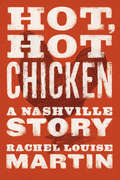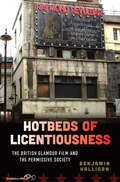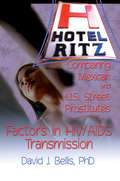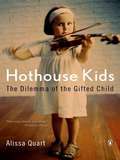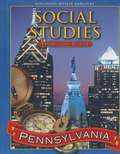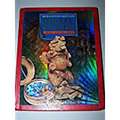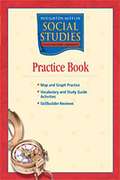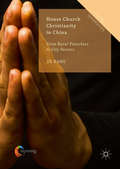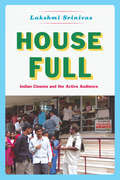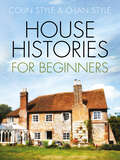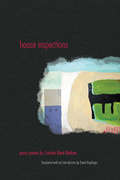- Table View
- List View
Hot, Hot Chicken: A Nashville Story
by Rachel Louise MartinThese days, hot chicken is a &“must-try&” Southern food. Restaurants in New York, Detroit, Cambridge, and even Australia advertise that they fry their chicken &“Nashville-style.&” Thousands of people attend the Music City Hot Chicken Festival each year. The James Beard Foundation has given Prince&’s Chicken Shack an American Classic Award for inventing the dish. But for almost seventy years, hot chicken was made and sold primarily in Nashville&’s Black neighborhoods—and the story of hot chicken says something powerful about race relations in Nashville, especially as the city tries to figure out what it will be in the future.Hot, Hot Chicken recounts the history of Nashville&’s Black communities through the story of its hot chicken scene from the Civil War, when Nashville became a segregated city, through the tornado that ripped through North Nashville in March 2020.
Hotbed: Bohemian Greenwich Village and the Secret Club that Sparked Modern Feminism
by Joanna ScuttsThe dazzling story of the Greenwich Village feminists who blazed the trail for the movement&’s most radical ideasOn a Saturday in New York City in 1912, around the wooden tables of a popular Greenwich Village restaurant, a group of women gathered, all of them convinced that they were going to change the world.It was the first meeting of &“Heterodoxy,&” a secret social club. Its members were passionate advocates of free love, equal marriage, and easier divorce. They were socialites and socialists; reformers and revolutionaries; artists, writers, and scientists. Their club, at the heart of America&’s bohemia, was a springboard for parties, performances, and radical politics. But it was the women&’s extraordinary friendships that made their unconventional lives possible, as they supported each other in pushing for a better world.Hotbed is the never-before-told story of the bold women whose audacious ideas and unruly acts transformed a feminist agenda into a modern way of life.
Hotbeds of Licentiousness: The British Glamour Film and the Permissive Society
by Benjamin HalliganHotbeds of Licentiousness is the first substantial critical engagement with British pornography on film across the 1970s, including the “Summer of Love,” the rise and fall of the Permissive Society, the arrival of Margaret Thatcher, and beyond. By focusing on a series of colorful filmmakers whose work, while omnipresent during the 1970s, now remains critically ignored, author Benjamin Halligan discusses pornography in terms of lifestyle aspirations and opportunities which point to radical changes in British society. In this way, pornography is approached as a crucial optic with which to consider recent cultural and social history.
Hotbeds of Licentiousness: The British Glamour Film and the Permissive Society
by Benjamin HalliganHotbeds of Licentiousness is the first substantial critical engagement with British pornography on film across the 1970s, including the “Summer of Love,” the rise and fall of the Permissive Society, the arrival of Margaret Thatcher, and beyond. By focusing on a series of colorful filmmakers whose work, while omnipresent during the 1970s, now remains critically ignored, author Benjamin Halligan discusses pornography in terms of lifestyle aspirations and opportunities which point to radical changes in British society. In this way, pornography is approached as a crucial optic with which to consider recent cultural and social history.
Hotel Brasil
by Frei Betto Jethro SoutarAccording to the police, the victim was stabbed in the heart before the head was separated from the body. As the investigation continues other hotel clients are decapitated, usually with the head found delicately balanced on the knees of the sitting victim. A witty, touching account of life at the edge of Brazilian society, dressed up as a murder mystery.
Hotel Dreams: Luxury, Technology, and Urban Ambition in America, 1829–1929 (Studies in Industry and Society)
by Molly W. BergerWinner, 2012 Sally Hacker Prize, Society for the History of TechnologyHotel Dreams is a deeply researched and entertaining account of how the hotel's material world of machines and marble integrated into and shaped the society it served. Molly W. Berger offers a compelling history of the American hotel and how it captured the public's imagination as it came to represent the complex—and often contentious—relationship among luxury, economic development, and the ideals of a democratic society.Berger profiles the country's most prestigious hotels, including Boston's 1829 Tremont, San Francisco's world-famous Palace, and Chicago's enormous Stevens. The fascinating stories behind their design, construction, and marketing reveal in rich detail how these buildings became cultural symbols that shaped the urban landscape.
Hotel Life: The Story of a Place Where Anything Can Happen
by Matthew Pratt Guterl Caroline Field LevanderWhat is a hotel? As Caroline Field Levander and Matthew Pratt Guterl show us in this thought-provoking book, even though hotels are everywhere around us, we rarely consider their essential role in our modern existence and how they help frame our sense of who and what we are. They are, in fact, as centrally important as other powerful places like prisons, hospitals, or universities. More than simply structures made of steel, concrete, and glass, hotels are social and political institutions that we invest with overlapping and contradictory meaning. These alluring places uniquely capture the realities of our world, where the lines between public and private, labor and leisure, fortune and failure, desire and despair are regularly blurred. Guiding readers through the story of hotels as places of troublesome possibility, as mazelike physical buildings, as inspirational touchstones for art and literature, and as unsettling, even disturbing, backdrops for the drama of everyday life, Levander and Guterl ensure that we will never think about this seemingly ordinary place in the same way again.
Hotel Ritz - Comparing Mexican and U.S. Street Prostitutes: Factors in HIV/AIDS Transmission
by R Dennis Shelby David J BellisExplore ways to reduce the rate of HIV infection in street prostitutes--and the inescapable connection between the heroin trade, prostitution, and HIV!This unique book draws on face-to-face interviews that the author conducted on the streets, with heroin-addicted street prostitutes in Southern California and their counterparts in four large Mexican cities. Author David James Bellis illustrates the significant--and surprising--differences in the risk of exposure to HIV and other STDs that exist between street prostitutes in the two countries arising from national differences in the legality, sociology, and economics of sex work. He points out that Mexican prostitutes, for whom sex work is a simple means of livelihood, are “choir girls” compared with their beaten-up, drug-addicted sisters north of the border who perform sex for drug money and are at much greater risk of HIV and other diseases, like Hepatitis C. This book explores those differences, suggesting new directions for United States prostitution and heroin-control policies--laws currently so interwoven that they reinforce each other, accounting for a deadly circle of crime and disease. In addition to the fascinating results of the author's interviews with 72 female street prostitutes in San Bernardino, California, and 102 more in Tijuana, Cd. Juárez, Cd. Victória, and Cuernavaca regarding their personal sexual, drug, and health practices, and their criminal histories, Hotel Ritz-Comparing Mexican and U.S. Street Prostitutes: Factors in HIV/AIDS Transmission explores: the licensing process for legal prostitutes in Mexico the medical testing that Mexico requires prostitutes to undergo the differences in what United States and Mexican prostitutes know about HIV transmission the difference in condom use between United States and Mexican prostitutes the potential benefits of reforming prostitution and drug laws in both countries the benefits of making methadone maintenence and syringes-and heroin-free for heroin-addicted prostitutes the proportion of United States/Mexican prostitutes who would quit the trade if they learned they had AIDS how the social support system in the United States (housing subsidies, TANF/AFDC money, food stamps, etc.) leads to a greater proportion of drug-addicted prostitutes than are found in Mexico Hotel Ritz-Comparing Mexican and U.S. Street Prostitutes: Factors in HIV/AIDS Transmission also provides you with a look at the hierarchy of female sex workers, an explanation of the etiology of AIDS transmission, and a concise history of heroin and prostitution. Helpful tables and an appendix containing the author's survey questions make the data in this well-referenced book easily understandable.
Hotels (Cutaways)
by Jules O'DwyerFrom Marienbad to the Bates Motel, cinematic hotels are more than a mere backdrop to a film’s action. They actively scaffold the formal, aesthetic, and narrative possibilities of cinema. This book takes a journey through spaces of temporary dwelling—hotels, inns, and motels—to delve into the dynamics and contradictions that structure modern life.Along the way, O’Dwyer considers questions of plot and eroticism, labor and globalization, and the ethics and economics of hospitality. Drawing on a broad array of films from European art cinema to experimental adult media, and placing cinema into dialogue with film theory and media history, Hotels explores both how and why the hotel has such a strong purchase on the cinematic imaginary.
Hothouse Kids
by Alissa QuartAlissa Quart's deeply disturbing account looks at the intensely competitive and frenzied lives of America's children. Travelling the country and talking to scores of parents, teachers and children she looks at the overhyped world of baby edutainment and 'better baby' early education programmes, takes the lid off the world of IQ testing and child competitions (from Scrabble and chess to child preaching), and explores the lives of particular children who have been identified as prodigies u from a four-year-old painter whose works sell for $300,000 to an eight-year-old professional skateboarder who is backed by nine corporate sponsors. And she asks the questions that many parents find themselves asking. Where should parents and teachers draw the line? How do we establish when children are being under-stimulated or over-stretched? And can the hothousing of children lead to irreparable problems later in life? Hothouse Kids is a thought-provoking, often shocking exploration of a subject that is only too worryingly topical.
Houdini, Tarzan, and the Perfect Man: The White Male Body and the Challenge of Modernity in America
by John F. KassonA remarkable new work from one of our premier historiansIn his exciting new book, John F. Kasson examines the signs of crisis in American life a century ago, signs that new forces of modernity were affecting men's sense of who and what they really were.When the Prussian-born Eugene Sandow, an international vaudeville star and bodybuilder, toured the United States in the 1890s, Florenz Ziegfeld cannily presented him as the "Perfect Man," representing both an ancient ideal of manhood and a modern commodity extolling self-development and self-fulfillment. Then, when Edgar Rice Burroughs's Tarzan swung down a vine into the public eye in 1912, the fantasy of a perfect white Anglo-Saxon male was taken further, escaping the confines of civilization but reasserting its values, beating his chest and bellowing his triumph to the world. With Harry Houdini, the dream of escape was literally embodied in spectacular performances in which he triumphed over every kind of threat to masculine integrity -- bondage, imprisonment, insanity, and death. Kasson's liberally illustrated and persuasively argued study analyzes the themes linking these figures and places them in their rich historical and cultural context. Concern with the white male body -- with exhibiting it and with the perils to it --reached a climax in World War I, he suggests, and continues with us today.
Houghton Mifflin Harcourt Social Studies: Pennsylvania
by Houghton Mifflin Harcourt Publishing Company StaffA Pennsylvania social studies textbook for 4th graders, that takes a step by step approach to learning and practicing key social studies skills.
Houghton Mifflin Social Studies Student Edition Supplement Grade 3: World Communities
by Houghton MifflinSocial Studies Student Edition Supplement Grade 3 World Communities
Houghton Mifflin Social Studies: Western Hemisphere And Europe (Houghton Mifflin Social Studies)
by Houghton Mifflin Company Staff<P>HOUGHTON MIFFLIN <P>SOCIAL STUDIES <P>WESTERN HEMISPHERE & EUROPE <P>GEOGRAPHY AND CULTURE
Houghton Mifflin Social Studies: World Cultures and Geography, Practice Book
by Houghton MifflinNIMAC-sourced textbook
Houghton Mifflin: My World Poster Book [Kindergarten]
by Ludwig Achim von ArnimNIMAC-sourced textbook
Hound Pound Narrative: Sexual Offender Habilitation and the Anthropology of Therapeutic Intervention
by James B WaldramThis is a detailed ethnographic study of a therapeutic prison unit in Canada for the treatment of sexual offenders. Utilizing extensive interviews and participant-observation over an eighteen month period of field work, the author takes the reader into the depths of what prison inmates commonly refer to as the "hound pound." James Waldram provides a rich and powerful glimpse into the lives and treatment experiences of one of society's most hated groups. He brings together a variety of theoretical perspectives from psychological and medical anthropology, narrative theory, and cognitive science to capture the nature of sexual offender treatment, from the moment inmates arrive at the treatment facility to the day they are released. This book explores the implications of an outside world that balks at any notion that sexual offenders can somehow be treated and rendered harmless. The author argues that the aggressive and confrontational nature of the prison's treatment approach is counterproductive to the goal of what he calls "habilitation" -- the creation of pro-social and moral individuals rendered safe for our communities.
Hounded: Women, Harms and the Gender Wars
by Jenny LindsayThe last decade has seen countless cases of women being fired, disciplined, protested or no-platformed for their views on sex and gender. Whether high-profile celebrities or previously unknown feminists, such women’s vocal non-belief in ‘gender identity’ as a universal human condition bears a high social cost. These ‘houndings’ are often presented starkly, clinically, in headlines or fleeting social media moments, stripped of the true cost of holding such beliefs.But what is the reality behind the headlines and noise? What are the true consequences of holding – and living with - such seemingly now-heretical thoughts?Hounded charts the often hidden and unspoken harms women face for prioritising and defending sex-based language and rights. Outlining the often-bewildering array of tactics used by opponents against such women, as well as the resilience required to refuse to be silenced, Lindsay presents a compelling argument for recognition of the individual and social harms that are being enacted under the auspices of ‘gender identity activism.’ This debut non-fiction book by award-winning poet and essayist Jenny Lindsay, whose own ‘hounding’ offers a unique perspective, is a solid, sane, witty but also compassionate account about the very human cost of this extraordinary cultural and political schism.
House Church Christianity in China: From Rural Preachers to City Pastors (Global Diversities)
by Jie KangThis book provides a significant new interpretation of China's rapid urbanization by analyzing its impact on the spread of Protestant Christianity in the People's Republic. Demonstrating how the transition from rural to urban churches has led to the creation of nationwide Christian networks, the author focuses on Linyi in Shandong Province. Using her unparalleled access as both an anthropologist and member of the congregation, she presents a much-needed insider's view of the development, organization, operation and transformation of the region's unregistered house churches. Whilst most studies are concerned with the opposition of church and state, this work, by contrast, shows that in Linyi there is no clear-cut distinction between the official TSPM church and house churches. Rather, it is the urbanization of religion that is worthy of note and detailed analysis, an approach which the author also employs in investigating the role played by Christianity in Beijing. What she uncovers is the impact of newly-acquired urban aspirations for material goods, success and status on the reshaping of local Christian beliefs, practices and rites of passage. In doing so, she creates a thought-provoking account of religious life in China that will appeal to social anthropologists, sociologists, theologians and scholars of China and its society.
House Full: Indian Cinema and the Active Audience (Fieldwork Encounters and Discoveries)
by Lakshmi SrinivasIndia is the largest producer and consumer of feature films in the world, far outstripping Hollywood in the number of movies released and tickets sold every year. Cinema quite simply dominates Indian popular culture, and has for many decades exerted an influence that extends from clothing trends to music tastes to everyday conversations, which are peppered with dialogue quotes. With House Full, Lakshmi Srinivas takes readers deep into the moviegoing experience in India, showing us what it's actually like to line up for a hot ticket and see a movie in a jam-packed theater with more than a thousand seats. Building her account on countless trips to the cinema and hundreds of hours of conversation with film audiences, fans, and industry insiders, Srinivas brings the moviegoing experience to life, revealing a kind of audience that, far from passively consuming the images on the screen, is actively engaged with them. People talk, shout, whistle, cheer; others sing along, mimic, or dance; at times audiences even bring some of the ritual practices of Hindu worship into the cinema, propitiating the stars onscreen with incense and camphor. The picture Srinivas paints of Indian filmgoing is immersive, fascinating, and deeply empathetic, giving us an unprecedented understanding of the audience's lived experience--an aspect of Indian film studies that has been largely overlooked.
House Histories for Beginners
by Colin Style O-Lan StylePopular television programmes highlight the satisfaction that can be gained from investigating the history of houses, and there is always plenty of interest in the subject, with archives becoming ever more accessible with access to the internet.As the subject covers a broad field, the authors have set out to include advice on those aspects that usually apply to a project and others that will be of particular use for beginners. The reader is guided through every stage of research, from the first exploration of the archives to the completion of the task. Suggestions are also included on how to present the findings – a house history makes a very attractive gift.The authors describe how to deduce the age of a property (it is very seldom directly recorded when a house was built) and characteristics of research on particular types of property – such as cottages, manor houses, inns, mills, former church properties, and farms – are discussed. In one example, research demonstrated that a farm was likely to have been a Domesday manor – a fascinating discovery achieved using records accessible to any beginner.
House Inspections
by David Keplinger Carsten René Nielsen"These poems do much more than blur the line between illusion and reality: they evoke that vibrant contradiction of dreaming in which the real and unreal exist in perfect simultaneity."--The Georgia Review Theatre A man performs whole days from his life as a drama, each day at home in his apartment. He goes to great lengths to be as realistic as possible, walking around the apartment and tending to day-to-day business. Only at night, when he sits by himself in the kitchen, does he peek now and then at the window to glimpse his audience. He won't completely abandon the notion that someone is out there. It's like when you stand on the landing, in front of a closed door, and you can't help thinking that someone is watching through the peephole. With a dozen poems previously published in The Paris Review, Carsten René Nielsen is already a familiar name to US poetry readers. These dark prose poems--reminiscent of Charles Simic--map out a uniquely European territory with chilling, cinematic clarity. Award-winning Danish poet Carsten René Nielsen is the author of nine books of poetry, including his US debut The World Cut Out with Crooked Scissors (2007). His poems appear in The Paris Review, Agni, Circumference, Mid-American Review, Mississippi Review, and elsewhere. He lives in Aarhus, Denmark. David Keplinger's poetry awards include the Colorado Book Award, T.S. Eliot Prize, an NEA fellowship, and grants from the Danish Arts Council. He directs the MFA program at American University in Washington, DC.
House Inspections (Lannan Translations Selection Series)
by Carsten René Nielsen"These poems do much more than blur the line between illusion and reality: they evoke that vibrant contradiction of dreaming in which the real and unreal exist in perfect simultaneity."—The Georgia Review Theatre A man performs whole days from his life as a drama, each day at home in his apartment. He goes to great lengths to be as realistic as possible, walking around the apartment and tending to day-to-day business. Only at night, when he sits by himself in the kitchen, does he peek now and then at the window to glimpse his audience. He won't completely abandon the notion that someone is out there. It's like when you stand on the landing, in front of a closed door, and you can't help thinking that someone is watching through the peephole. With a dozen poems previously published in The Paris Review, Carsten René Nielsen is already a familiar name to US poetry readers. These dark prose poems—reminiscent of Charles Simic—map out a uniquely European territory with chilling, cinematic clarity. Award-winning Danish poet Carsten René Nielsen is the author of nine books of poetry, including his US debut The World Cut Out with Crooked Scissors (2007). His poems appear in The Paris Review, Agni, Circumference, Mid-American Review, Mississippi Review, and elsewhere. He lives in Aarhus, Denmark. David Keplinger's poetry awards include the Colorado Book Award, T.S. Eliot Prize, an NEA fellowship, and grants from the Danish Arts Council. He directs the MFA program at American University in Washington, DC.
House Life: Space, Place and Family in Europe
by Donna Birdwell-Pheasant Denise Lawrence-ZúñigaThis book, which fills a gap on the materiality of lived relations, examines households within the context of their immediate physical surroundings of home and shows how human interactions are reflected in built forms. Houses are dynamic participants in family life in many ways. They often pre-date the origins and outlast the life spans of their inhabitants, but they can exert a powerful influence on the organization of behaviors and the values of family members, as well as on the forms and flows of family life across the generations. Constituting wealth, investment, security and inheritance, they are an objective in and of themselves in many domestic strategies. Drawing on developments within anthropology, archaeology, architecture and social history, the authors demonstrate, through detailed case studies, how household or family relations can usefully be mined to re-situate social theory in both space and time. Space, boundaries, family cycles, historic changes, migration patterns, ethnicity, memory and gender are all interrogated for the light they shed on how people interact with the physical world around them and what this means culturally and symbolically. Europe is an especially rich focus for this kind of analysis because it is distinguished by its long, well-documented history and a recent period of intense change.
